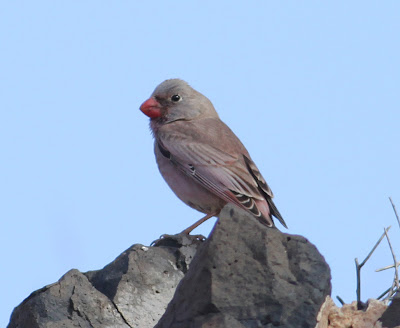The whole country seems to have come to a standstill via The Beast from The East. Here on the Lancashire coast we escaped the worst of the snow with just a smattering of snow showers but days of minus temperatures. The easterly wind chill factor has made for bitterly cold and unfavourable birding weather. Even the garden has been devoid of birds except for Starlings and one or two Goldfinch. Sue spent most of yesterday looking through the window but then about 4pm, I let her in the house.
So in the absence of any news and until the weather relents, I’m posting about our holiday to the warmer climes of Fuerteventura, The Canary Islands in January 2013.
Although holding a certain attraction, the beaches of Fuerteventura weren’t the sole interest in our holiday. A hire car for a few days gave a chance to explore the island although at approximately 650 square miles there’s a lot of ground to cover, and a pure white car isn’t the best colour for approaching cautious birds.
Remember to "Click the pics" for a close-up tour of the birds and the island.
The plains above Costa Calma and La Pared hold Houbara Bustards, Cream-coloured Coursers and Stone Curlew, but in a couple of tries we didn’t have much luck apart from 3 distant Stone Curlew and brief views of a running Courser.
There were lots of Lesser Short-toed Larks on the dry, open plains with small gangs of Linnets and occasional Southern Grey Shrikes. The Linnets are very unapproachable, as are the Goldfinches that can be glimpsed in greener parts of the island.
We journeyed through the centre of the island through the village of Betancuria and on to the highest parts of the island at 600 meters, giving a spectacular outlook on the landscape below and distant views of an Egyptian Vulture. This species is apparently now rare on the island as they are elsewhere in its range and we had just two sightings of the vulture in two weeks.
A walk exploring the outskirts and the village of Betancuria provided Sardinian Warbler, Blackcap, Chiffchaff, Kestrel, African Blue Tit, Spectacled Warbler and Trumpeter Finch. The latter three were all new birds for me with the wary Trumpeter Finch a particular favourite, due to its slightly comical appearance.
Trumpeter Finch
A few Spectacled Warblers were in song, and I guess the breeding season is quite early in these parts.
The so named Canary Islands Stonechat is actually found on Fuerteventura only where it is said to be best found in the dried up river beds, the barrancos, dotted around the island. I found them in a couple of locations where houses ran down to the beach, one time finding one feeding on the tide wrack with Berthelot’s Pipits, until I disturbed it whereupon it flew chat-like to the nearby fence. To me they appeared much like a very dark-headed Whinchat rather than a Stonechat.
Berthelot's Pipit
Berthelot's Pipit
Canary Islands Stonechat - By Frank Vassen [CC-BY-2.0 (http://creativecommons.org/licenses/by/2.0)], via Wikimedia Commons
Exploring Fuerteventura
It seems were are stuck with the Arctic weather for a few more days but there will be a little local birding and ringing soon. Don'y miss it.
Linking today to Anni's Birding Blog and Eileen's Blog.
Linking today to Anni's Birding Blog and Eileen's Blog.













































































